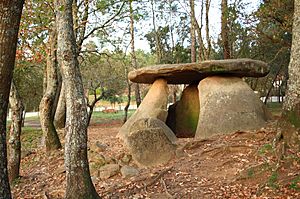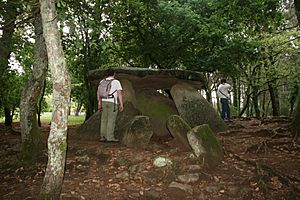Dolmen de Axeitos facts for kids
The Dolmen de Axeitos is a very old stone structure. It is a type of megalithic dolmen, which means it was built using large stones. This ancient monument is located near the village of Axeitos, in the area of Ribeira, in northern Spain. It sits on the Barbanza Peninsula, close to the Ría de Arousa.
This dolmen is incredibly old. Experts believe it was built between 4000 and 3600 BC. That's over 5,600 years ago! Because it is so important to history and archaeology, it became a protected landmark on March 11, 1978. In Spain, this protection is called a "Bien de Interés Cultural." This means it's a special site that must be preserved.
Contents
What is a Dolmen?
A dolmen is a type of ancient tomb or monument. It was built during the Neolithic period. This was a time when people started farming and living in settled communities. Dolmens are usually made from several large upright stones. These stones support a big, flat capstone on top.
Many dolmens were used as burial chambers. They might have held the remains of important people. They could also have been places for special ceremonies. The Dolmen de Axeitos is a great example of these amazing ancient structures.
Where is the Dolmen de Axeitos Located?
The Dolmen de Axeitos is found in Galicia, a region in northwestern Spain. It's specifically in the Province of A Coruña. You can find it northwest of the small village of Axeitos. This area is known for its beautiful coastline and rich history.
The dolmen is on the Barbanza Peninsula. This peninsula stretches into the Atlantic Ocean. It is near the Ría de Arousa, which is a large estuary. An estuary is where a river meets the sea. The location shows how ancient people used the landscape.
Why is the Dolmen de Axeitos Important?
This dolmen is important for several reasons. First, it is a very old example of human construction. It shows us how people lived and built things thousands of years ago. Studying dolmens helps archaeologists understand ancient cultures. They learn about their beliefs, their tools, and their social structures.
Second, its status as a "Bien de Interés Cultural" highlights its value. This protection ensures that the dolmen will be preserved. Future generations can continue to learn from this historical site. It is a link to our distant past.
See also
 In Spanish: Dolmen de Axeitos para niños
In Spanish: Dolmen de Axeitos para niños



